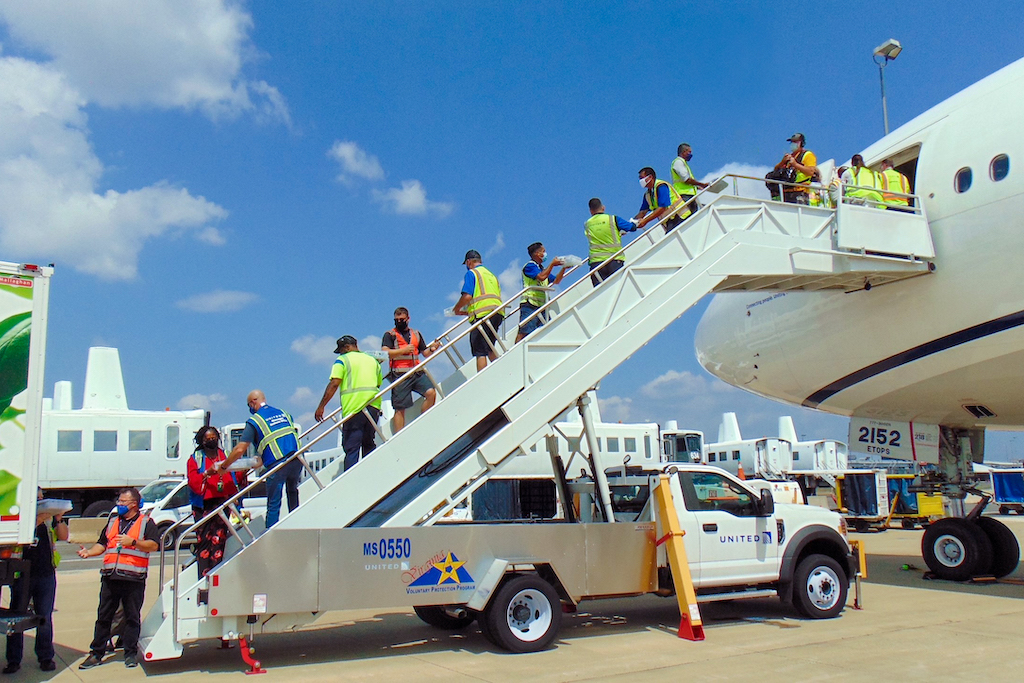Pentagon Evacuation Deployment Could Boost Airlines' Top Line in Third Quarter

Photo Credit: United's first civil reserve air fleet flight arrived at Washington Dulles with roughly 340 Afghanistan evacuees on August 23. United Airlines
When several U.S. carriers were activated to help with the evacuation efforts in Afghanistan, they were quick to say that the operations would not impact their businesses.
It turns out that the flights, part of the Civil Reserve Air Fleet and ordered by the Pentagon on August 22, may actually boost participating airline revenues in the third quarter — a period when revenues otherwise face downward pressure from the Covid-19 Delta variant.
Each civil reserve fleet carrier flies under a "cost-plus" contract, or one where the Department of Defense pays the costs of the flights plus a previously agreed to profit margin. In addition, participation gives carriers preferential treatment for non-civil reserve military charter contracts. At least American Airlines, Delta Air Lines, Hawaiian Airlines and United Airlines are participating moving Afghanistan evacuees.
“These are probably good opportunities for them to be able to fly those aircraft and get paid for it," said Daniel Friedenzohn, an associate dean and professor of aeronautical science at Embry-Riddle Aeronautical University.
In non-pandemic times, activation could be a drag on airlines' earnings. The logistics of taking large, wide-body aircraft out of their regular schedule can be disruptive, and the cost-plus contracts can be worth less than flying the planes on lucrative long-haul routes where travelers can pay thousands of dollars for posh lie-flat seats.
But these are not normal times. Long-haul international travel down as much as 40 percent per trade group Airlines for America (A4A), and American, Delta, Hawaiian and United are all utilizing their wide-body jets less than in normal times. Some even still have some aircraft in storage, including at least three Airbus A330s and Boeing 767s at Delta.
"It isn't a huge amount of flying, and it is of unknown duration, so exactly how much impact it would make is unknown, though it will be earnings accretive," said Robert Mann, an adviser at R.W. Mann & Company and former airline executive. How accretive will depend on how long the U.S. keeps the civil reserve fleet activated.
The deadline for the U.S. to exit Afghanistan is August 31, however, there is growing pressure on President Biden to extend that amid fears that some evacuees will be left behind in the country.
But even a month of cost-plus flying with several wide-body jets could boost airlines' top lines amid the continuing impact of the Covid-19 pandemic. For the third quarter, American has forecasted a 20 percent drop in revenues compared to 2019; Delta a 30-35 percent decrease; and United a roughly 22 percent reduction. These forecasts, made before any negative impact from the Delta variant, may prove overly optimistic. Frontier Airlines, Southwest Airlines and Spirit Airlines have all since cited the variant in lowering their September quarter outlooks.
And activation is resource intensive. Each airline dedicates several wide-body aircraft to fly evacuees from military installations in the Middle East — not Afghanistan itself — to Europe and the U.S., as well as the staff and supplies needed to support those flights. At United, some 8,000 staff are working both on the ground and in the air with the civil reserve flights; the first flight — likely of many — arrived at Washington Dulles with roughly 340 evacuees on Monday. And Delta is procuring extra "masks, water, wipes, amenity kits, diapers, pillows, blankets and baby formula" and staging aircraft at Dulles, it has told staff in multiple internal communiques
In total, 18 aircraft have been activated as part of the civil reserve air fleet. Four at United, all Boeing 777-300ERs; three each at American, Atlas Air, Delta — either A330s, A350s or 767-300ERs — and Omni; and two at Hawaiian, all A330s.
